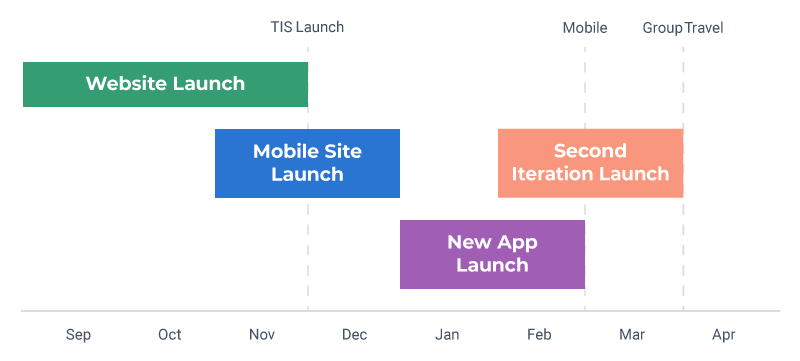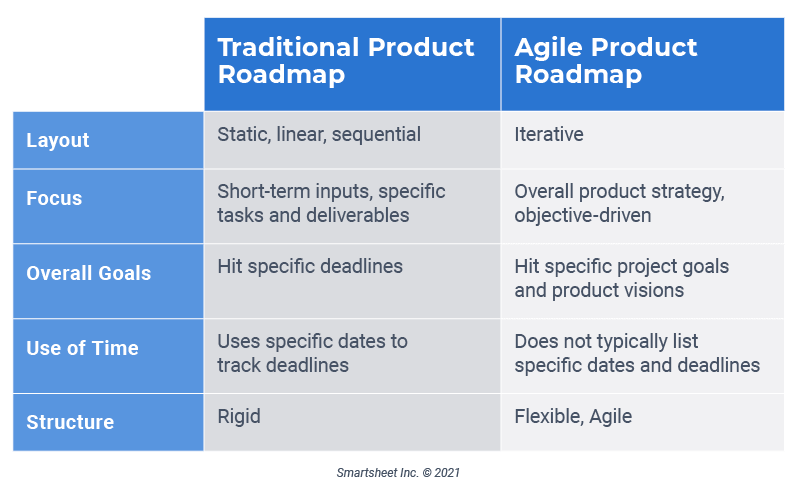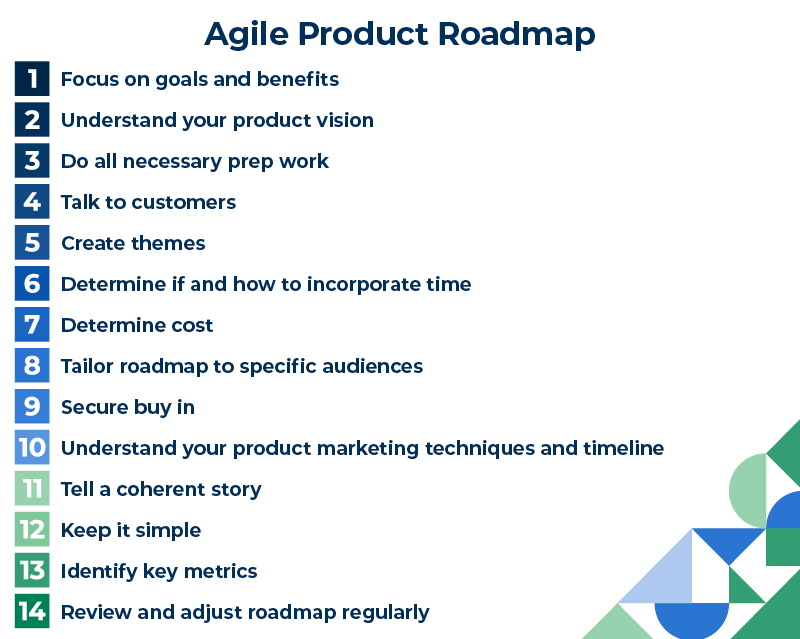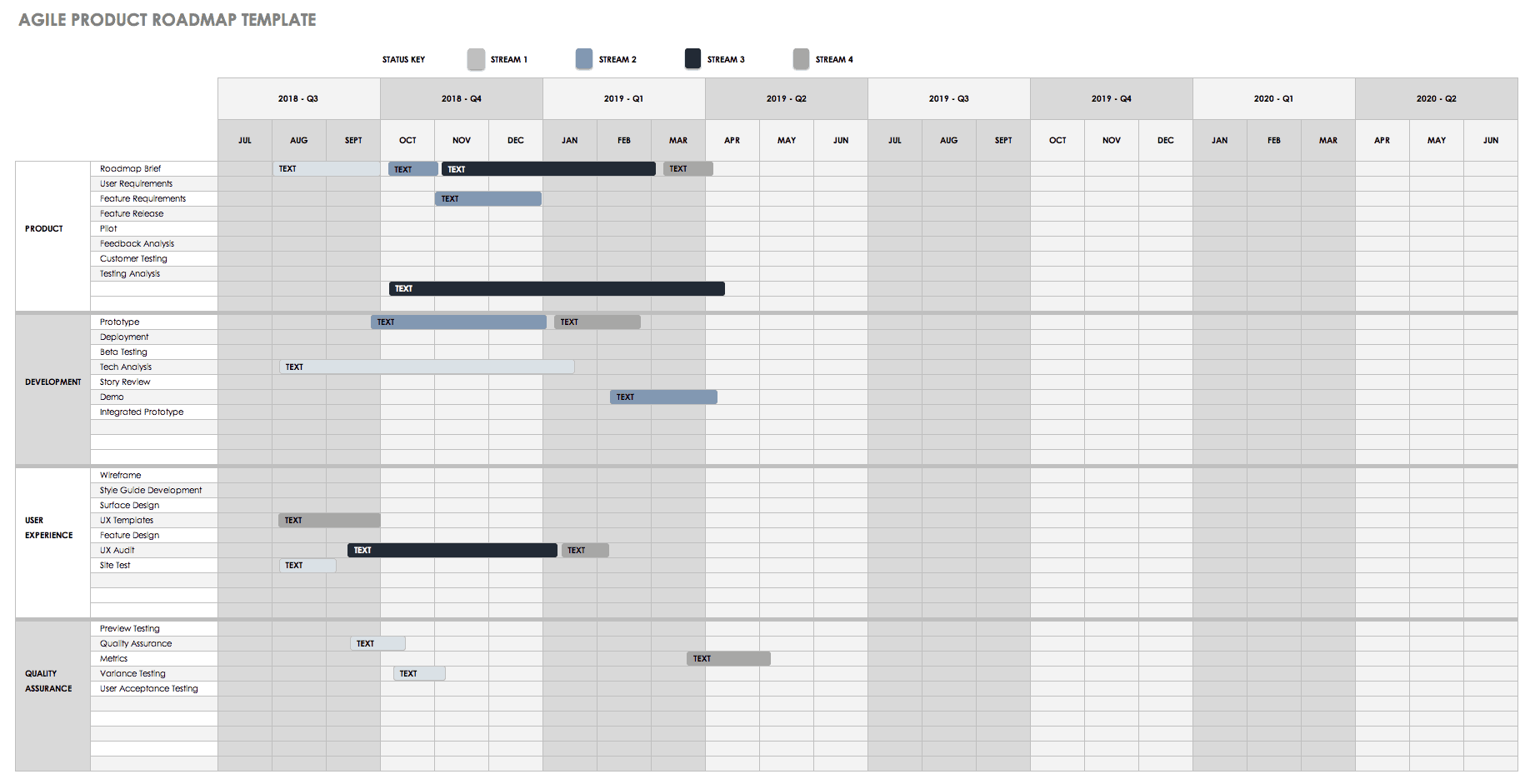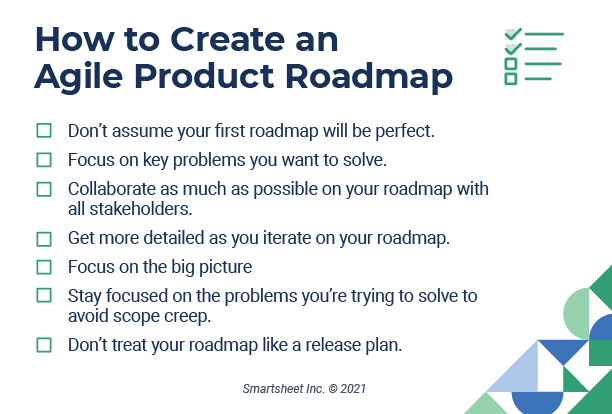What Is an Agile Product Roadmap?
An Agile product roadmap is a tool that details your company’s plan for achieving a strategic product vision. It also explains how a specific product is likely to change, align with stakeholders, and bring in ROI.
Product owners use this type of roadmap to outline projected product functionality and identify potential release dates. An Agile product roadmap can be more challenging than traditional product roadmaps because, in an Agile environment, change happens quickly and frequently, so the roadmap must be able to withstand these changes and evolve with the project.
What Does An Agile Product Roadmap Look Like?
An Agile product roadmap looks different from a traditional product roadmap and is usually organized by themes, key goals and objectives, and new features.
An Agile product roadmap is typically not linear or based on specific inputs and outputs. Instead, it is iterative and plots potential updates against more general themes and company-wide objectives and key results (OKRs) and goals.
If you’re looking for specific, preformatted templates to help get you started, visit our article with a wide variety of Agile product roadmap templates.
Traditional Product Roadmap vs. Agile Product Roadmap
A traditional product roadmap is a static, sequential diagram that lists short-term inputs that will achieve a long-term output and communicate each step of the project plan.
By contrast, an Agile product roadmap is not static, but instead provides an iterative method to track projects and communicate about overall strategy, rather than the specific steps or outputs associated with the plan.
According to Janna Bastow, CEO and Co-Founder of ProdPad, a product management and roadmapping software for product people, “Traditional product roadmaps map out a list of features or deliverables against a timeline, whereas an Agile product roadmap allows the team to be more flexible. Instead of being date- or feature-driven, an Agile roadmap is usually centered around a series of objectives.”
Additionally, she says, “Because an Agile roadmap isn’t locked to dates, but rather to goals, teams that work in an Agile way tend to be more experimentation-driven and outperform delivery-led teams, in terms of hitting outcomes.”
Traditional roadmaps are typically not ideal for Agile projects, as these projects are constantly evolving while the team completes new sprints and different iterations. Instead, Agile product roadmaps focus on outcomes rather than outputs; they are designed to showcase themes and project epics, rather than specific features or steps.
When to Use a Traditional vs. an Agile Product Roadmap
An Agile product roadmap is best used for iterative projects that are objective-driven, while a traditional product roadmap is most helpful for linear projects focused on specific deliverables and deadlines.
Refer to the comparison chart below to note the differences between the two types of roadmaps, so you can decide which one is right for your use case.
Essential Elements of an Agile Product Roadmap
An Agile product roadmap includes many of the same elements as a traditional product roadmap, such as a timeline, specific product features, and a status key for in-progress, planned, and approved projects. It also has such components as the following:
- Strategic Themes: Instead of specific outputs, an Agile product roadmap focuses on specific themes that represent the larger product and business strategies that will help direct the roadmap. There may be multiple themes within a single product roadmap (for example, “Expand market share in the Asia-Pacific region” or “Eliminate wait time when downloading our product in order to retain customers”).
- Features: These can either be features you’re building or a hierarchy of broader feature themes around which you will plan your features.
- Business Goals: Strategic business goals and OKRs typically drive an Agile product roadmap. This gives team members an idea of where to focus their effort to help them achieve these goals, which can either be product- or business-specific (for example, “Launch a new external dashboard” or “Increase active users by 25 percent”).
How Do You Create an Agile Product Roadmap?
To create the most effective product roadmap in an Agile environment, product owners will first need to outline new product functionality and releases, as well as take into account resourcing and engineering constraints, value propositions, budget, and competition.
Steps in the Agile Roadmapping Process
There are many important steps in the Agile roadmapping process to ensure you create, implement, and review your roadmap appropriately. Follow the steps below to start creating your best, most effective Agile product roadmap.
- Focus on Product Goals: Before you begin drafting your product roadmap, identify all business objectives and key performance indicators (KPIs) associated with your product goals, such as acquiring new customers or increasing product engagement. The roadmap should be driven by the goals of your product, rather than by the specific features required to achieve those goals (usually, you’ll only have three to five features per goal).
- Understand Your Product Vision: Once you understand your product goals, start to nail down the specific vision of your product and how it will deliver value to your customers. Your product vision should be concise and compelling. It should also be appropriately high-level; should any unforeseen roadblocks occur, you can adjust it easily without harming your overall goals.
Bastow cautions: “Don’t just jump straight into creating a whole roadmap. Make sure you have defined and clarified your product vision with your team first, as this provides your roadmap with direction. Once you have a vision, work with your team to identify your objectives. After all, if you don’t know what success looks like, you won’t know if the work on your roadmap is actually working.” - Do the Necessary Prep Work: Prep work includes identifying the product strategy, which is the path you will take to realize your product vision, as well as the steps in your actionable roadmap. Create a product vision board to help brainstorm strategy ideas and facilitate roadmap creation. Remember, the roadmap is a living document that will ultimately change, so anticipate those changes and allow for lots of flexibility within your vision and corresponding roadmap.
- Talk to Your Customers: To get the best idea of how to meet your customers needs — and ultimately, how you should plan your product roadmap — hold candid conversations with your customers and gain insight into their wants and needs. These conversations should take place with both internal customers and end users.
- Create Product Themes: Once you’ve done your prep work and talked to customers, make a comprehensive list of the problems you’re trying to solve. These issues will then become the main themes around which you organize your product roadmap. As you come up with these themes, prioritize them based on the KPIs and product vision you identified in earlier steps.
Bastow reiterates the importance of this step: “[Your product roadmap] should be made up of initiatives or, rather, problems that could be solved in order to meet your product vision. Think of these initiatives as stepping stones — if you step on them in the right order, you’ll maximize your chances of hitting the objectives you outlined.” - Determine If and How to Incorporate Time: Ask yourself if time is relevant to your product roadmap. Typically, with internal-facing roadmaps, it’s more common to share dates so team members can track task execution and communicate progress to cross-functional teams, such as marketing and sales. On external-facing roadmaps, you might not want to show timelines, as doing so could tie you to those dates. Regardless, avoid committing to specific dates throughout the delivery of your product so as to avoid setting unrealistic expectations for both internal and external stakeholders.
- Determine Cost: As with any project, it’s important to determine resourcing and the labor costs, materials, licenses, facilities, and infrastructure involved in your product development, in order to come up with an accurate projected cost.
- Tailor Your Roadmap to Specific Audiences: Roadmaps are supposed to communicate and align stakeholders and team members, so pay attention to your audience and know what’s important to each audience. For example, you may want to show a high-level overview to your executive team, but use a more granular roadmap showing tasks and epics with your development team.
- Secure Buy-In: As you develop your roadmap, collaborate often with key stakeholders and your development team, so everyone feels like they have a say and are striving toward the same goals. If possible, leverage a Scrum master to facilitate this sort of communication among team members.
- Understand Your Product Marketing Techniques and Timelines: Pay close attention to the features that your product marketing team announces to the market, and maintain a user-centric outlook to collect knowledge on what the market is looking for. Keep up with the wants and needs of your users and update your roadmap accordingly.
- Tell a Coherent Story: As a whole, your roadmap should tell a story about how you see your product evolving and iterating over time. The roadmap should include specific goals that build upon each other, with breakdowns into specific, measurable goals that you can look back on to measure progress and success.
- Keep It Simple: Keep your roadmap as simple and concise as possible, and avoid adding too many details. Stick only to the goals that are most important to your product development, and avoid showing specific user stories on the roadmap (instead, you may note those stories in the product backlog).
- Identify Key Metrics: Make sure that every goal on your roadmap is measurable so you can report on its success. For example, one of your goals could be to retain active users, meaning that you could look back on your product roadmap and identify whether your new developments affected customer retainment.
- Review and Adjust the Roadmap Regularly: Check in regularly with your Agile product roadmap and review it with your stakeholders and development team as often as needed. Keep the roadmap up to date with your product strategy, and ensure that it always reflects your organization’s larger priorities. Since you’re working in an Agile environment, it’s important to be flexible with your plans and stay on top of any changes that affect your roadmap.
The Agile Product Roadmap Lifecycle
An Agile product roadmap should follow the lifecycle of your product. You should update and change it as your product roadmap evolves.
Agile Product Roadmap Starter Kit
This Agile product roadmap starter kit offers you everything you need to begin assembling your first Agile roadmap, including a free template, a step-by-step guide on how to create a roadmap, and best practice tips and tricks.
Download Agile Product Roadmap Template
Microsoft Excel | Microsoft Word | Microsoft PowerPoint | Smartsheet
Download Agile Product Roadmap Best Practice Tips & Tricks Checklist - PDF
Expert Tips for Creating an Agile Product Roadmap
Agile product roadmap experts emphasize the need to focus on problems you want to solve with your roadmap and the importance of relying on your team to help you achieve your goals.
Other expert tips include the following:
- Don’t Assume Your First Roadmap Will Be Perfect: “Your first roadmap will not be perfect — far from it,” says Bastow. “As a matter of fact, I like to think of the roadmap as a prototype, but for your product strategy. Prototypes are a way to test assumptions and check that you’re on the right track. Designers prototype their work all the time. The goal isn’t to create the perfect version straight away, but to present your assumptions and use the prototype to encourage a healthy discussion around the ideas presented.”
- Focus on the Key Problems You Want to Solve: The goal of your roadmap is to map out how to solve the problems you identified with your team. Bastow says, “Your first ‘roadmap’ can be as simple as a few sticky notes that outline some key problem areas. Put them in the order you think is best, based on what you currently know about the business and market.”
- Collaborate: As mentioned previously, your first Agile product roadmap won’t be perfect, and it won’t stand a chance of passing the sniff test if you try to create it all on your own. According to Bastow, once you create your roadmap, “take that roadmap to other stakeholders: a colleague, a trusted customer, or anyone with a different perspective. They will help fill in any gaps, and point out where your assumptions might be wrong. Perhaps you learn that you need to change the order of your steps, or you need to consider a new problem on your roadmap.”
- Add More Details as You Iterate: Once you’ve come up with an initial roadmap, you can start to flesh out the details and identify specific areas you want to address. “The next version of your roadmap would be more detailed and more robust,” says Bastow. “After several rounds of feedback, you’ll have a lot more confidence in your roadmap, even though it probably looks nothing like the first version.”
Why Agile Teams Need an Agile Product Roadmap
It’s important to connect the work your team is doing back to a specific roadmap in order to ensure your team is on track and to provide context to each of the tasks within a roadmap.
Additionally, as project tools, product and project roadmaps provide people with a high-level overview of what’s coming down the line and how to prepare, whether for the budget or resources. Specifically in an Agile environment, a project roadmap helps to maintain visibility during the many iterations and changes that occur as an Agile project evolves and progresses.
An Agile roadmap also can help you identify top priorities and the themes associated with them, which can enable both you and your team to focus your time and resources on the highest-impact items.
Lastly, teams need to leverage a roadmap as a critical communication tool — to help relay the product strategy internally as well as cross-functionally. Doing so helps get stakeholder buy-in by giving everyone a view into project expectations.
The Benefits of Agile Product Roadmaps
You can find many benefits associated with an Agile-specific product roadmap, including the following:
- Improved team confidence in leadership’s ability to make better, more strategic decisions
- Better insurance on a product’s arrival to market by focusing on short-term iterations rather than long-term problems
- Improved ability to answer customer’s needs by talking with the customer and getting a firsthand look at their new requests from the product
- Better balance between short-term results, such as product releases, and long-term results, such as overall business objectives
- According to Bastow, the ability to prioritize your roadmap and associated tasks “at the problem level, not at the idea level”
How to Use an Agile Product Roadmap
The best way to use an Agile product roadmap is as a high-level overview of projected product releases and improvements.
Executives can use the roadmap to gain better insight into what’s coming down the line, how work is progressing, and where roadblocks might occur.
Development teams can use the roadmap to actually execute on the work, such as product updates and launches. The roadmap will also give these team members better insight into the projected launch date of each release, which in turn gives each person the ability to weigh in on how the roadmap should change as the project progresses and evolves.
All in all, an Agile product roadmap should be shared cross-functionally so that all stakeholders and team members are looped in on what’s going on from start to finish.
What Does the Agile Roadmapping Process Look Like in Practice?
There are many use cases for Agile product roadmaps, and each process looks a little different, depending on the business objectives, themes, and goals. Below, find examples of different types of Agile product roadmaps for various teams in an organization.
- Leadership Roadmap: This type of roadmap is aimed at giving senior leadership and key stakeholders a high-level overview of the product team’s projects and progress. It provides insight into the overall product direction, with emphasis on additional key information, such as market share, market opportunities, and budget. These types of roadmaps are also known as objective timeline roadmaps.
- Company Roadmap: A company roadmap focuses on sharing specific product details with cross-functional teams, such as sales and customer success, to offer them insight into the expected timelines for product releases and new launches. This allows them to set expectations with existing customers and deliver on customers’ wants and needs. These roadmaps are also referred to as release plans or release timeline roadmaps.
- Delivery-Focused Roadmap: This type of roadmap includes more specific timelines for the development teams that are directly involved in the product development. It helps to communicate objectives, areas of product features, the status of product development, and resourcing information. These are very similar to sprint plans and feature timeline roadmaps.
- Customer-Focused Roadmap: Use a customer-focused roadmap to identify the features that your customers care about the most (and, therefore, want the product team to develop). This roadmap helps to communicate upcoming features for customer-facing audiences that sales, customer success, and marketing teams can announce. It is sometimes referred to as a general release plan or a now-next-later roadmap.
Examples of Agile Product Roadmaps
Below, you’ll find examples of specific Agile product roadmaps that you can use for a variety of use cases, from developing a release plan to assigning a now-next-later status to product features and iterations.
| Name of Agile Product Roadmap | Description of Roadmap |
|---|---|
| Release Plan | This type of roadmap provides an execution-level plan that specifically identifies how you will deliver work and the associated timeline, if applicable. A release plan provides a high-level overview of future product releases, which makes it ideal for roadmaps that have a fixed scope, but are not necessarily time-bound. |
| Sprint Plan | A sprint plan focuses on specific product deliveries and is most helpful for sprint planning. Generally, product teams use sprint plans to sync their development teams with the upcoming work and plan sprints over a predetermined timeline so they can properly fund and resource each sprint appropriately. |
| Now-Next-Later Roadmap | Use this type of roadmap to communicate task priority levels within a certain timeframe. This way, teams can see the most important tasks in the “now” and “next” table; the “later” table shows features that might be coming down the line. |
| Kanban Roadmap | A Kanban roadmap is delivery-focused and intended specifically for development teams. This roadmap provides product teams with specific initiations, which are grouped into buckets for planning, in-progress, and completed states, as well as the product backlog. |
| Feature Timeline Roadmap | This output-driven roadmap includes a predetermined timeline for each individual feature, which gives teams a high-level overview of how work is progressing and what features are set to come next. This roadmap specifically helps align development teams with key stakeholders, so everyone stays up to date on feature progress against specific timelines. |
| Objectives Timeline Roadmap | This roadmap offers a more specific, zoomed-in look at each objective within a roadmap on a predetermined timeline. An objectives timeline roadmap aligns all parts of the organization with overall product direction and helps to communicate the product strategy and goals for the next few weeks, months, and quarters. |
How and When to Update Your Agile Product Roadmap
You should regularly review your product roadmap, usually every one to three months, depending on the total projected length of your project, to update it as the project evolves.
Update your roadmap as often as your product plans change — keep an eye on it and make your roadmap as collaborative as possible. This also ensures that your product teams don’t become overly obsessed with the dates on the roadmap since dates shift and plans evolve many times in Agile environments.
Best Practices and Strategies for Agile Product Roadmaps
As you create your Agile product roadmap, remember to think of your roadmap in terms of problems you want to solve rather than new ideas you want to explore.
Additionally, remind yourself of these best practices as you plan and iterate on your product roadmap:
- Focus on the Bigger Picture: Remain committed to the larger picture you want to build with your roadmap, rather than on specific tasks or product developments.
- Stay Focused on the Problem You’re Trying to Solve, and Don’t Waver: According to Bastow, doing so will “ensure that you’re solving the right problems first, and not falling prey to all the usual biases (like noisy customers or demanding stakeholders).”
- Don’t Treat Your Roadmap Like a Release Plan: As Bastow notes, “A release plan is a tactical, short-term planning document that’s useful for a specific audience: usually those closest to the engineering cycles. A roadmap is a completely different sort of artifact. It’s a strategic communication document that shows the path you’re looking to take to meet your product vision and allows you to sense-check your assumptions with stakeholders. It’s designed to be flexible and have a different level of granularity than your release plan, as well as a different purpose and set of stakeholders, so keep these documents separate.”
For additional best practices and tips from experts regarding product roadmaps, both for an Agile environment and for more general use cases, visit our article that highlights these tips and talks to a plethora of experts.
Streamline Agile Product Execution with Smartsheet for Project Management
Timeline view in Smartsheet empowers users to plan, visualize, and collaborate on date-based work in real-time, enabling you to effortlessly organize tasks, track progress, and communicate status.
In just a few clicks, launch your project’s timeline on any sheet to visualize your work, understand the details, and adjust information, making it easy to track project progress, detect blockers, and communicate statuses.
Discover how timeline view in Smartsheet can help your team visualize date-based work and achieve greater efficiency and transparency across projects.
Learn more about timeline view in Smartsheet.
